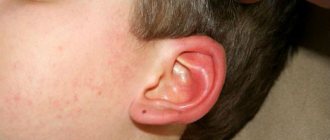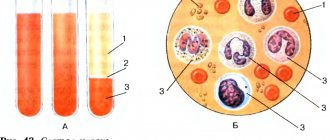Hemorrhage is a dangerous symptom.
No matter the location or cause, this is always a dangerous sign of pathology that requires urgent medical intervention.
This also applies to bleeding from the eyes. Hemorrhage in the eyes occurs due to a violation of the integrity of the vascular wall. But that's not the reason. This is the final point of a complex mechanism resulting from a specific pathological incident in the body.
Hemorrhage may resolve on its own or may lead to permanent vision loss. In any case, if a symptom occurs, an early ophthalmological examination is necessary.
Causes of bleeding from the eyes
There are different concepts - bleeding from the eyes and hemorrhage into the cavity of the eyeball or orbit. The first condition is hemolacria, or the release of blood along with tear fluid. This is a very rare symptom. This condition can be caused by trauma, tumors or infection of the lacrimal glands and ducts, acute injuries to the skull, and poison intoxication (from a snake bite). History describes cases of hemolacria in young people and children, which appeared and disappeared suddenly. No processes that could cause this strange condition have been identified.
The described cases remain a mystery. A rare cause of hemolacria in women is extragenital endometriosis, usually a congenital malformation. This is the growth of endometrial tissue (the inner layer of the uterus) on other organs, in particular on the conjunctival membrane. In this disease, blood comes from the eyes during menstruation.
The second concept is hemorrhage in the eye - a state of bleeding into the structures of the eye, between them, into the orbital cavity. There are many causes for this symptom:
- increased intraocular pressure in glaucoma;
- retinal disinsertion;
- injury to the eyeball (contusion) or base of the skull (symptom of glasses);
- excessive physical activity;
- severe emotional stress;
- prolonged overstrain of the organ of vision;
- sudden dive to depth (diving);
- sudden jumps in blood pressure;
- sharp uncontrolled jumps in blood sugar - from high hyperglycemia to deep hypoglycemia;
- autoimmune diseases accompanied by vascular damage (systemic vasculitis);
- DIC syndrome, blood clotting disorders;
- severe vitamin K deficiency;
- taking antiplatelet agents and anticoagulants (to thin the blood);
- neoplasms of the eye elements (their pressure on the structures of the eye and blood vessels causes a violation of their integrity);
- foreign object entering the eye;
- after major surgical operations.
A sudden dive to depth, physical and emotional overload lead to a rapid increase in pressure inside the blood vessels. Since the vessels of the visual system are small with fragile walls, they suffer first.
Why do my eyes turn red?
Red eyes usually mean redness of the sclera, the white membrane of the eye. The sclera contains a significant number of capillaries - the smallest blood vessels. Usually they are invisible, but under the influence of a number of circumstances, the blood vessels of the sclera can expand, the walls of the vessels stretch as they expand, and then we see them, or rather, we see the blood filling the vessels. The blood is red, causing the eyes to appear red.
In most cases, dilation of scleral vessels is caused by a sharp increase in blood circulation. This is how the body responds to a fairly wide range of problems. Blood is an internal transport through which nutrients are delivered and toxins are removed. Blood flow helps increase local immune defense and accelerates healing. In many cases, the redness of the eyes goes away quite quickly; this means that the blood supply to the sclera has returned to normal. If the redness persists for a long time, then, obviously, the problem that caused it is quite serious.
Risk group
People at risk of intraocular hemorrhage include patients with hypertension and diabetes mellitus. These are patients who do not control blood pressure or sugar levels and do not receive constant rational therapy.
Therefore, they are at risk of not only vascular complications. Irrational and uncontrolled treatment also includes thoughtless use of blood thinning drugs. These categories of people need regular examination by specialized doctors and control of tests with due frequency.
The risk group includes people with the pathological conditions presented above. This also includes those who enjoy scuba diving. This is an extreme activity. Professional training is required before diving. This also applies to lovers of skydiving, ski jumpers and those involved in a more dangerous type of jumping from cliffs and from extremely high points. A full medical examination and appropriate permission are a prerequisite for engaging in such activities.
Professional athletes whose activities involve high speeds, running, fighting, and jumping are therefore at risk. They can get injured at the base of the skull (from a fall), or to the eyes (in martial arts, football players). Athletes and bodybuilders are in a state of constant physical overstrain. This is an additional risk factor for ocular hemorrhages.
People addicted to alcohol. Alcoholic drinks in large quantities cause aggression. People intoxicated often get involved in fights, which do not always end well.
No one is immune from neoplasms. Until now, it has not been possible to identify a reliable reason for the development of cancer cells in humans. Therefore, prevention consists of maintaining immunity, regular examinations by doctors for early detection of the tumor and its removal in the first stages of the disease.
People in stressful professions - doctors, lawyers, businessmen. Shop workers and miners are susceptible to the penetration of foreign bodies into the eyeball. It is very important for them to wear personal protective equipment when working. Workers in hot shops are exposed to changes in temperature and pressure, which also poses a risk of surges in intravascular pressure.
What to do if your eyes are red
First of all, you should eliminate the cause that caused the redness of the eyes.
If redness of the eyes is a consequence of overwork, you need to give your eyes a rest. Sleep helps eliminate redness: after all, when we sleep, our eyes rest. A full eight-hour sleep will in many cases help eliminate redness of the eyes.
In the modern world, many types of activities involve working at a computer. Your eyes get very tired if you have to look at the screen all the time. It is necessary to avert your eyes to the side, blink on purpose, and even better, give your eyes a rest by closing them for a couple of minutes from time to time.
Perhaps the redness of the eyes is an allergic reaction. It is necessary to remove anything that can cause allergies. If you start using new cosmetics, put them aside. Use only natural hygiene products. Avoid contact with pets.
If the redness of the eyes does not go away, you should consult a doctor.
Classification of hemorrhages
Depending on the structure of the eye that has undergone bleeding, there are:
- hemophthalmos;
- hyphema;
- subconjunctival hemorrhage - hyposphagma;
- retinal - into the retina;
- into the orbit, soft tissues of the eye.
Hyphema is the penetration of blood into the anterior chamber of the eye. This condition is a common consequence of blunt trauma to the eye area and is accompanied by pain. Hemophthalmos is characterized by bleeding into the vitreous body - this is a complex and dangerous condition that requires urgent resolution. Symptoms include the appearance of fog before the eyes, which does not go away with blinking, and blurred vision. The retina is the most sensitive part of the eyeball. Small changes in blood vessels easily lead to bleeding. Disposing of excess blood from the retina without damaging its functions is not an easy task.
Hemorrhages can be classified according to severity - from mild to severe, according to the breadth of distribution and involvement of other structures, unilateral or bilateral, for reasons - ocular and somatic.
Symptoms
The main symptom of hemolacria is the discharge of blood from one eye or from two organs of vision at once. Tears may have a bright bloody scarlet color, a light reddish tint, or contain streaks and inclusions of blood particles.
Helpful information! One small tear of blood may go unnoticed, but a person literally crying blood is sure to attract attention.
Along with blood in the eyes, other accompanying symptoms may be observed: pain, burst eye vessels, itching or burning of the visual organs, visual disturbances (flashes, spots, lightning, narrowing of visual fields, blurred vision), as well as general signs such as malaise, increased body temperature, weakness and others.
First aid
First aid for hemorrhage involves immediately calling an ambulance or going to an emergency room yourself. Before providing medical assistance, you should apply ice (any cold object) to the eye area.
It is forbidden to rub your eyes - this will increase the bleeding, and a possible infection that has penetrated into the blood will spread throughout the body.
You cannot use eye drops yourself or try to remove a foreign body. It is necessary to wait for the doctor, who will explain in detail the circumstances of the occurrence of the process, inform about existing diseases, allergies and medications taken.
Injuries to the cornea of the eye
Most often, corneal injuries are caused by scratching with a fingernail or other foreign body, but more serious injuries, such as chemical burns, can also occur.
All corneal wounds are divided into linear and patchwork. They can be of various sizes and shapes. Clinical manifestations: lacrimation, photophobia, eye pain, blepharospasm. If an infection occurs, inflammatory infiltration of the wound edges can be detected.
To diagnose a non-perforated corneal wound, in addition to anamnestic and clinical data, the following method is used: drops of a fluorescein solution (1%) are instilled into the conjunctival sac, followed by rinsing with a sodium chloride solution (isotonic). The injured area of the cornea will turn yellow-green.
Treatment
Analgesics are not used for injury to the cornea of the eye, because this delays the healing process. Epithelization occurs within a few days without leaving a trace. If the damage was deep, it is possible that after healing there will be an area of cloudiness, which (sometimes) reduces visual acuity. In general, the prognosis for corneal injuries is favorable.
Treatment
Eye bleeding should only be treated by a doctor. Depending on the severity of the disease, the doctor chooses conservative or surgical treatment. Hyposphagma tends to resolve on its own. The doctor's help consists of excluding serious pathology, infection, prescribing decongestant, anti-inflammatory solutions and monitoring the dynamics.
Therapy is selected strictly individually. Surgery may be required. If a lot of time has passed since the injury and the wound has festered, removal of the eye is not excluded.
The task of the victim and his immediate environment is not to panic, provide first aid, deliver the patient to a medical facility as soon as possible, and strictly follow medical prescriptions.
When should you see a doctor if your eyes are red?
It is necessary to consult a doctor immediately if redness of the eyes is accompanied by symptoms such as:
- nausea and vomiting;
- Strong headache;
- blurred vision;
- Pain in the eyes;
- photophobia;
- any discharge from the eyes.
Why does inflammation occur?
Most non-purulent inflammations of the cornea are of infectious origin. More than 70% of all diagnoses are related to viral activity.
The most common causative agents of keratitis
This type is considered:
- herpes simplex and herpes zoster virus;
- adenoviruses (this variant is more often found in children);
- measles and chickenpox viruses.
If the cornea of the eye is inflamed and purulent exudate is present in the conjunctival sac, the cause of the pathology is a nonspecific or specific bacterial infection. Pathogens in this group include:
- nonspecific bacteria - pneumococci, streptococci and staphylococci, Pseudomonas aeruginosa and Escherichia coli;
- protozoa - Klebsiella and Proteus;
- specific bacteria and protozoa - causative agents of tuberculosis, syphilis, malaria, chlamydia, gonococcus and salmonella.
Inflammations caused by the activity of amoebas of the genus Acanthamoeba are included in a separate group. They cause the most severe damage to the cornea and deep-seated structures of the eye. Such infections are common among people with visual impairments who use contact lenses. They also have a common candidiasis, that is, fungal inflammation of the cornea.
Inflammation does not necessarily require an infectious component.
. In some cases, pathology develops due to:
- autoimmune reactions due to hay fever, taking certain medications or helminthic infestations, rheumatoid arthritis and Sjogren's syndrome;
- intraoperative consequences or complications due to inflammation of the mucous membranes of the eye, lacrimal sac and tubules, sebaceous glands or ciliary follicles;
- endogenous influences - prolonged deficiency of vitamins B, A, C, a general decrease in immunity or chronic systemic diseases accompanied by metabolic disorders (gout, diabetes, etc.).
Also in ophthalmology, inflammation of the cornea due to intense exposure to ultraviolet radiation has been recorded. In this case, we are talking about a separate diagnosis - photokeratitis.
Hypoxic reasons:
hypoxic “stress” during over-wearing of lenses, prolonged wear or insufficient cleaning, sterile infiltrates of the cornea, ingrowth of blood vessels into the cornea. Hypoxia - (ancient Greek ?π? - under, below + Greek οξογ?νο - oxygen; oxygen starvation) - reduced oxygen content in the body or individual organs and tissues, in this case - in the cornea. The cornea is the anterior transparent shell of the eyeball, one of the main refractive media of the optical system of the eye. Since SCLs completely cover the surface of the cornea, they obviously influence the metabolic processes in it to one degree or another. It is important to understand that the cornea does not have blood vessels and receives oxygen mainly from the atmosphere through the tear film. During sleep, oxygen comes from the anterior chamber and limbal vasculature.
Acute “hypoxic” stress in SCL users can occur after sleeping in lenses, wearing lenses beyond the recommended period, with improper fit, with continuous or prolonged wear. It may be accompanied by subepithelial infiltrates at the limbus (in the place where the limbal vasculature is located), in which case “corneal syndrome” may appear - lacrimation, photophobia, foreign body sensation.
Ingrowth of blood vessels into the cornea occurs in cases of chronic hypoxia as a protective mechanism in order to increase the delivery of oxygen to “starving” tissues. Newly formed vessels are structurally defective and, in cases of severe neovascularization, create an unaesthetic picture of constant irritated red eyes, forcing the patient to refuse contact correction completely.
Contact lenses are made from materials with different ability to transmit oxygen, and accordingly, the impact of hypoxia factors on the cornea will be different. It is important to strictly adhere to the wearing regimen recommended for each type of lens and for each patient individually in order to avoid hypoxic complications.
How to treat bleeding in the eye
Subconjunctival hemorrhage in most cases does not require treatment and goes away on its own.
If you experience pain and discomfort, your doctor may prescribe decongestant and anti-inflammatory drops. For concomitant eye infections, antibacterial or antiviral drugs are prescribed. As a rule, subconjunctival hemorrhage resolves within 2 weeks, without complications.
In other cases of hemorrhages in the eye, immediate treatment is required in an eye hospital.
Blunt mechanical damage
Due to a blow to the eyeball, bone bed or facial skeleton with a voluminous object, for example, a ball, fist, stone, stick, etc., blunt mechanical injury may occur. Often such injuries are accompanied by contusion of the organs of vision, hemorrhages in the tissue of the eye and eyelids, as well as fractures of the walls of the eye orbit. In some particularly severe cases, such injuries are accompanied by traumatic brain injury.
It is worth noting that mechanical injury of this type is extremely dangerous for the eye. The consequence of this injury may be partial retinal detachment.
In case of blunt mechanical impacts, a comprehensive examination of the visual system is mandatory and surgical assistance is provided as necessary. After this, a protective binocular bandage is applied to the affected eye. To prevent infectious and fungal complications, antibiotics are prescribed. To speed up the process of resorption of hemorrhages, electrophoresis using potassium iodide may be required.
Signs of blunt mechanical damage:
- Swelling of the organs of vision;
- Hemorrhages in the tissue of the eye and eyelids;
- Acute pain;
- Abnormal position of the damaged organ (displacement and problems with mobility);
- Headaches and dizziness.
Prices for diagnostic services and consultation with an ophthalmologist
| Type of medical service | Service price in rubles |
| Consultation with an ophthalmologist for eye disease in an adult | 500 |
| Consultation with an ophthalmologist for eye diseases in children over 3 years of age | 700 |
| Biomicroscopy of eye structures | 400 |
| Skiascopy | 400 |
| Direct ophthalmoscopy of the fundus with a narrow pupil | 400 |
| Direct ophthalmoscopy with a wide pupil (under mydriasis) | 400 |
| Indirect ophthalmoscopy with a binocular ophthalmoscope | 500 |
| Diaphanoscopy of the eye and its appendages | 500 |
| Gonioscopy | 500 |
| Ophthalmotonometry according to Maklakov | 250 |
| Daily tonometry – (2 times a day, 3 days) | 1000 |
| Non-contact ophthalmotonometry | 300 |
| Elastometry | 300 |
| Shortened tonography according to Nesterov | 500 |
| Colored nasolacrimal test | 200 |
| Schirmer test | 200 |
| Eyelid massage (1 procedure, 2 eyelids) | 300 |
| Collection of material and examination for demodex | 1000 |
| Taking a smear for flora and sensitivity to antibiotics from the conjunctiva | 1000 |
| Probing and rinsing of lacrimal canaliculi | 1000 |
| Removing a foreign body from the cornea of the eye | 1000 |
| Injecting medications into a chalazion | 1000 |
| Barley opening | 1000 |











